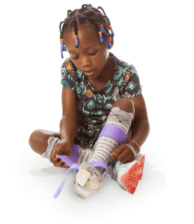What is spastic diplegic cerebral palsy?
 Spastic diplegic cerebral palsy is a form of spastic CP that primarily affects movement in the legs. It causes muscle stiffness, tightness, and jerky movements that make walking and balance difficult.
Spastic diplegic cerebral palsy is a form of spastic CP that primarily affects movement in the legs. It causes muscle stiffness, tightness, and jerky movements that make walking and balance difficult.
Some children may have mild coordination issues in their arms, but symptoms in the legs are usually more pronounced.
This type of cerebral palsy is often linked to brain damage in areas that control movement, typically occurring before, during, or shortly after birth.
Children with spastic diplegic cerebral palsy often require physical therapy, mobility aids, and long-term support to build independence and manage daily activities.
In some cases, the brain injury may have been caused by a preventable birth injury. If so, families could be eligible to file a cerebral palsy lawsuit and pursue financial compensation.
Cerebral Palsy Guide works with a network of top birth injury lawyers across the country. Our legal partners have recovered over $1 billion for families affected by cerebral palsy and other birth injuries.
Get a free case review now to see if you may qualify for financial support to help with your child’s lifelong care.
Symptoms of spastic diplegic cerebral palsy
Spastic diplegic cerebral palsy mainly affects the legs, though some children may also show mild involvement in the arms. Symptoms can range from subtle motor issues to more severe mobility challenges.
Recognizing early signs of cerebral palsy helps families get timely care and support that can improve long-term outcomes.
- Abnormal gait (like toe walking or scissor gait)
- Balance problems
- Delayed developmental milestones (like sitting or crawling)
- Hypertonia (increased muscle tone in the legs)
- Limited range of motion
- Muscle stiffness (spasticity)
- Poor coordination
- Trouble maintaining posture or balance
- Weakness in the lower limbs
Children with spastic diplegic cerebral palsy often benefit from physical therapy, occupational therapy, and assistive devices that support safer mobility and more independence.
If you have questions about your child’s symptoms, talk with one of our on-staff registered nurses for free.
They can help you understand the condition and explain next steps — including whether you may qualify for financial support.
Connect with a caring registered nurse right now.
Risk factors for spastic diplegic cerebral palsy
Spastic diplegic cerebral palsy is caused by brain damage that usually occurs during pregnancy, labor, or shortly after birth. Certain risk factors may increase the chances of this type of brain injury.
- Advanced maternal age (over 35)
- Exposure to infections during pregnancy
- Low birth weight (under 5.5 pounds)
- Maternal health conditions like preeclampsia (involving dangerously high blood pressure)
- Multiple gestation (twins, triplets, etc.)
- Premature birth (before 37 weeks)
- Pregnancy or delivery complications that affect oxygen supply
- Substance use or toxin exposure during pregnancy
Doctors are trained to monitor and manage these risks. If they fail to do so and your child develops spastic diplegia, you may be able to sue for cerebral palsy and pursue compensation to help cover their lifelong care.
Causes of spastic diplegic cerebral palsy
Spastic diplegic cerebral palsy is caused by damage to the brain’s motor pathways. This damage affects how the brain communicates with muscles, leading to chronic stiffness and movement challenges, most often in the legs.
In rare cases, brain damage may occur later in infancy due to illness or injury, but most cases begin near the time of delivery.
- Birth asphyxia (oxygen deprivation during labor or delivery)
- Fetal stroke (bleeding or blockage in the brain’s blood vessels before birth)
- Head trauma during a complicated delivery
- Infections in the mother or baby, such as meningitis or chorioamnionitis
- Kernicterus, a type of brain damage from untreated newborn jaundice
- Maternal health issues, including gestational diabetes or preeclampsia
- Medical negligence, such as delayed C-sections or poor monitoring
- Placental complications that limit blood or oxygen supply
If medical professionals failed to prevent the brain damage that caused your child’s spastic diplegic CP, you may be eligible to file a cerebral palsy lawsuit and recover money for care, therapy, and future needs.
Get a free case review right now to see if you may qualify.
Complications of spastic diplegic CP
Children with spastic diplegic cerebral palsy often experience complications that affect their mobility, development, and overall health. These issues usually stem from ongoing muscle stiffness, abnormal posture, or reduced motor control.
- Ankle deformities due to muscle imbalance and improper foot positioning
- Chronic pain or muscle fatigue
- Constipation (chronic bowel issues related to limited mobility)
- Developmental delays in motor and functional milestones
- Emotional or behavioral challenges due to limited mobility
- Hearing or vision problems
- Incontinence (bladder or bowel control difficulties)
- Joint contractures (permanent joint stiffness from untreated spasticity)
- Malnutrition, especially in children with feeding challenges
- Respiratory issues linked to poor posture or limited mobility
- Scoliosis (spinal curvature that worsens with age and muscle imbalance)
- Seizures and epilepsy in some children with underlying brain injury
Early diagnosis and consistent care from pediatric health care providers, including orthopedists and neurologists, can help reduce the severity of these complications and improve long-term outcomes.
Treatment options for spastic diplegia
Spastic diplegic cerebral palsy is a lifelong condition, but treatment can help ease symptoms, improve mobility, and support a better quality of life.
Many children benefit from assistive devices like braces, walkers, or communication tools, depending on their needs and abilities. Therapies aim to improve motor function and independence in children with CP.
Learn more about spastic diplegic cerebral palsy treatment options below.
Medications
Cerebral palsy medications help reduce spasticity, manage pain, and control related conditions like seizures.
Common medications for spastic diplegic cerebral palsy include:
- Anticholinergics (glycopyrrolate) to reduce drooling or tremors
- Anticonvulsants (lamotrigine, topiramate, carbamazepine) to control seizures
- Botulinum toxin (Botox®) injections to ease leg stiffness and improve movement
- Muscle relaxants (baclofen, diazepam, dantrolene) to relieve spasticity and discomfort
These medications are often used as part of a broader care plan that includes therapy or surgery.
Physical therapy
Cerebral palsy physical therapy is a cornerstone of treatment for spastic diplegia. It helps strengthen muscles, improve balance, and stretch tight areas to prevent contractures.
Cerebral palsy spastic diplegia exercises can help improve strength, flexibility, and mobility in the legs. Children may use gait trainers, orthotics, or mobility aids as part of their therapy program.
Surgery for cerebral palsy
Cerebral palsy surgical procedures may be recommended to improve mobility, reduce pain, or correct deformities caused by long-term muscle tightness.
Surgical options include:
- Feeding tube placement for children who have trouble swallowing or gaining weight
- Orthopedic surgery to correct joint contractures or bone alignment
- Selective dorsal rhizotomy (SDR) to reduce leg spasticity by cutting nerve fibers in the spine
Surgery is typically only considered when other treatments haven’t worked and is followed by rehabilitation to help with recovery.
Other types of therapy for spastic diplegic cerebral palsy
Children with spastic diplegic cerebral palsy often benefit from both occupational and speech therapy.
Occupational therapy for CP builds the fine motor skills needed for daily tasks like dressing or using utensils.
Cerebral palsy speech therapy improves communication, understanding, and feeding. It may also include assistive devices for nonverbal children.
Therapies are often play-based to keep kids motivated while working on important developmental skills.
Prognosis of spastic diplegic cerebral palsy
There is no cure for spastic diplegic cerebral palsy, but it is not progressive — meaning the brain injury itself doesn’t worsen over time.
However, its effects on muscle tone, coordination, and mobility can be long-lasting and often require ongoing care.
A child’s long-term outlook depends on how severe their symptoms are. It can also be affected by co-occurring conditions, which are other health or developmental issues that happen alongside cerebral palsy.
- Cognitive impairments, such as intellectual disability or learning delays
- Feeding difficulties, including problems with chewing, swallowing, or weight gain
- Seizure disorders, like epilepsy, which may require long-term medication
With early intervention, physical therapy, and supportive treatment, many children with spastic diplegic cerebral palsy can increase their independence, reduce complications, and live meaningful lives.
Get legal help for spastic diplegia cerebral palsy
Children with spastic diplegia often face severe challenges. Unfortunately, managing cerebral palsy symptoms typically requires lifelong support.
For many families, the emotional and financial toll can be overwhelming. If a medical error caused your child’s condition, filing a cerebral palsy lawsuit may help you afford vital care like therapy, surgery, and mobility equipment.
A birth injury lawyer can determine whether your child’s spastic diplegia was preventable and if your family may qualify for compensation.
Cerebral Palsy Guide works with experienced birth injury lawyers who can help families in all 50 states.
The cerebral palsy attorneys in our network have secured over $1 billion for families nationwide. They may be able to help yours, too.
Call us right now at (855) 220-1101, or get a free case review to find out if you could be eligible for financial compensation.




